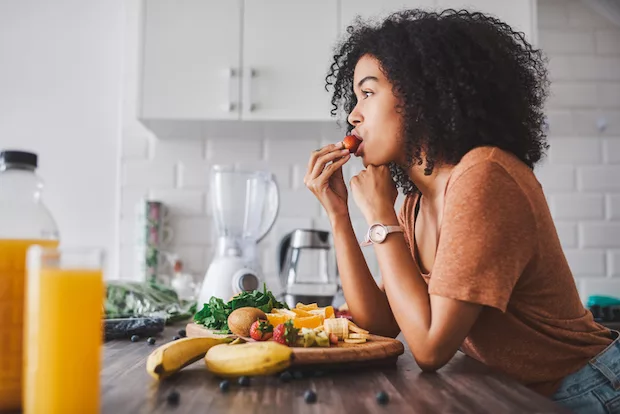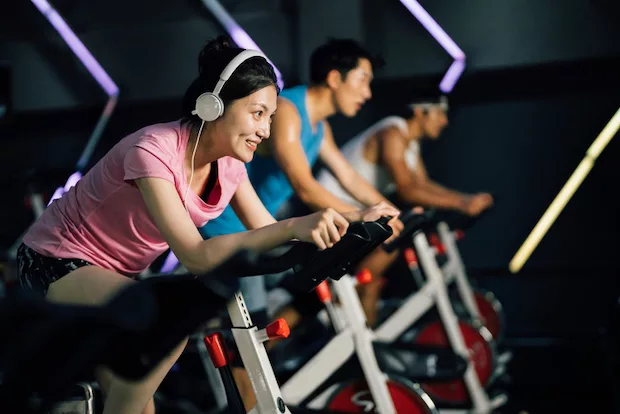Sure, we’re familiar with the term menstrual cycle—but how about cycle syncing? The practice involves adjusting your diet, exercise, and lifestyle habits throughout your menstrual cycle so you can feel great even before and during menstruation. Gaby Vaca-Flores, RDN, CLE, shares a play-by-play guide.
If you menstruate, you likely know all too that for a few days out of the month, you can expect to feel less than great (to put it lightly). However, there’s a way to conquer even your toughest PMS and period symptoms. Enter: cycle syncing.
Hormone changes throughout the different phases of your cycle can impact many aspects of your physical and mental health. But with strategic, healthy habits, you can do damage control with any ups and downs and feel your best all month long—even during the tougher parts of your cycle. Keep reading to learn how to become a cycle syncing pro.
Days 1-5: Menstruation
Day one of your cycle begins when your period, aka menstruation, starts. (As a reminder, a period is a result of the uterus shedding its inner lining and breaking down an unfertilized egg.) Menstruation typically lasts about five days. Keep in mind that every cycle can vary, so consider these numbers as an estimate of a typical cycle.
It’s also worth mentioning that menstruation falls under the umbrella of the follicular phase. In simple terms, the follicular phase describes the time in which an egg develops, matures, and releases. (More to come on this in the next couple of phases.)
Mind and Body
You may be feeling common symptoms like irritability, tiredness, bloating, breast tenderness, and general discomfort. These symptoms occur on account of dips in estrogen and progesterone levels. Low levels of these hormones are a normal response to an unfertilized egg.
Nutrition
Dietary habits can influence many areas of our bodies, and our hormones are no exception. In particular, traditional Western Diets are associated with PMS—symptoms of which may continue as your period begins. On the other hand, healthier eating patterns are associated with a lower likelihood of experiencing these symptoms, according to a case-control study that compared the eating habits of over 500 women with and without PMS.
Although PMS symptoms typically start up to a week before menstruation (which we’ll cover in a bit), certain dietary habits can help make your period feel easier. Specifically, prioritizing foods with certain nutrients like unsaturated fats, calcium, and vitamin B6 can help you feel better. As such, some of the best foods to eat while on your period include:
- salmon
- yogurt
- almonds
- turkey
- bananas
- beans
Limit foods that can worsen your symptoms, such as foods high in salt and unhealthy fats, including ultra-processed and fried foods. Also, try your best to keep caffeine and alcohol at a minimum as they too can worsen mood-related symptoms. Instead, reach for some warm tea, like chamomile, which can feel especially soothing during your period.
But as with everything, balance is key. If (moderately) indulging in your favorite, less nutritious food will bring some comfort during your period, allow yourself to do so.
Fitness
You might not feel inclined to get in an intense workout during the first couple days of your cycle. No one blames you—period discomfort is no joke. However, exercise may be effective in easing period symptoms. So instead of skipping your workout all together, you may benefit from focusing on light movement and low-intensity activities such as walking, yoga, or stretching.

Days 6-13: Pre-ovulation
Hooray, your period is over! Now you enter what’s known as pre-ovulation, which involves adopting new cycle syncing tips. While you’re still technically in the follicular phase, bleeding has stopped and so have the associated symptoms. On average, pre-ovulation lasts about a week. During this time, your body begins to prepare for the possibility of pregnancy.
Mind and Body
You’re probably feeling happier, more energetic, and simply relieved to be back to your usual self. These positive feelings are closely influenced by the shift in your hormone levels. At this time, estrogen levels are back on the rise. This process encourages the regrowth of the uterine lining.
Nutrition
Although you’re probably feeling better, try to maintain healthy food options as the focus of your diet. Specifically, now’s a good time to focus on foods that encourage estrogen function in the body. For instance, seek foods that deliver phytoestrogens, a compound that mirrors the effect of estrogen in the body.
Foods with phytoestrogens include:
- berries
- dried fruit
- edamame
- garlic
- seeds (flax and sesame)
- cruciferous veggies (broccoli, Brussels sprouts, cabbage)
- tempeh
Fitness
During the pre-ovulatory phase, we suggest slowly turning up the intensity in your workouts. Jogging, hiking, Pilates, and body weight exercises are all great examples of moderate fitness regimens to incorporate into your routine.
Build Your Supplement Routine
Take The HUM Quiz
Days 14-25: Ovulation & Post-Ovulation
Ovulation day, usually day 14, marks the end of the follicular phase. On this day, the ovaries release an egg into the fallopian tubes.
Then, post-ovulation begins. If the egg isn’t fertilized during its time in the fallopian tubes (i.e., it didn’t make contact with sperm), the egg will then make its way down to the uterus. Post-ovulation typically lasts less than 10 days and is also the start of the luteal phase.
Mind and Body
On day 14, you might be feeling some breast soreness or tenderness combined with mild pain in your lower abdomen. Some also feel changes in their libido. Many accompanying mood changes—such as stress, frustration, and sadness—are related to spikes in estrogen and luteinizing hormone (LH). These spikes help the unfertilized egg travel to the uterus.
After the hormone spike, estrogen and LH levels will drop and progesterone will rise in anticipation for menstruation (or pregnancy, if the egg is fertilized).
Nutrition
In terms of cycle syncing your diet at this point, I recommend keeping things simple and following similar eating patterns to that of the pre-ovulatory phase. As such, foods containing healthy fats, calcium, and vitamin B6 should remain at the top of your list.
Fitness
As you progress through the middle and final stages of your cycle, aim to incorporate workouts that are more challenging. Some examples of higher intensity workouts include HIIT circuits, running, spin classes, and strength training.

Days 25-28: Pre-Menstruation
The pre-menstruation phase entails the couple of days leading up to your period. Assuming that your egg was not fertilized, your body will signal the uterus to break down the egg and shed its inner lining. Pre-menstruation and the luteal phase will end once your period starts, marking the beginning of your next cycle.
Mind and Body
At this time, common PMS symptoms begin to manfiest. Again, these most often include a combination of mood-related and physical symptoms such as low energy and breast tenderness. This is mainly due to the gradual fall of estrogen and progesterone.
Additionally, women with PMS symptoms have been shown to have rising prolactin levels during pre-menstruation and menstruation.
Nutrition
In anticipation of your period, start easing off foods that can trigger PMS symptoms. Remember, this includes Western diet staples such as foods high in salt and unsaturated fats. Caffeine and alcohol can also worsen PMS symptoms, so it’s best to taper off your intake at this time.
Instead, focus on healthier food options and choose whole or minimally processed foods whenever possible. Be sure to check out my list of the best foods for PMS.
Fitness
Listening to your body will be the best move for you during the pre-menstruation phase. If your energy levels feel relatively normal, feel free to continue doing higher intensity workouts. On the other hand, if you find that your energy or mood is starting to take a hit, consider transitioning to workouts with moderate intensity.
The Takeaway
As we can see, hormone changes are at play throughout your entire cycle. These fluctuations can influence how we feel physically, mentally, and emotionally. Fortunately, supporting the health of your hormones—via these cycle syncing tips and otherwise—can help provide PMS relief, especially if you stay on top of your healthy habits all month long.
HUM’s SOS PMS gummies are specifically designed to relieve common PMS symptoms by supporting healthy hormone balance. This cranberry-flavored gummy is the first of its kind with a clinically tested dose of chasteberry that actually tastes great. In addition, it contains key ingredients to support urinary tract health and mood. (Just remember to take them daily to complement your cycle syncing diet plan.)
Clearly, your cycle is much more than just a period. Each phase brings about different hormonal changes. Syncing your diet and exercise routines can help you conquer not only your period, but your entire menstrual cycle so you can move through each phase with greater comfort.
The post How to Conquer Your Menstrual Cycle to Feel Your Best All Month Long appeared first on HUM Nutrition Blog.
---------------------------
By: Gaby Vaca-Flores
Title: How to Conquer Your Menstrual Cycle to Feel Your Best All Month Long
Sourced From: www.humnutrition.com/blog/cycle-syncing/
Published Date: Fri, 17 Feb 2023 20:55:22 +0000
Read More
Did you miss our previous article...
https://prohealthsciences.com/supplements-and-vitamins/how-to-change-your-relationship-with-food
 General Health and WellnessFitness and ExerciseSupplements and VitaminsPandemic NewsVideosPrivacy PolicyTerms And Conditions
General Health and WellnessFitness and ExerciseSupplements and VitaminsPandemic NewsVideosPrivacy PolicyTerms And Conditions
